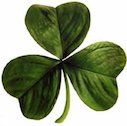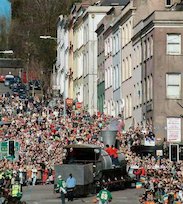St Patrick's Day

St Patrick is the Patron Saint of Ireland and his feast day is celebrated on 17th March. He was born in Britain, but was captured by Irish raiders and spent six years in slavery in Ireland. He escaped and returned to his family and joined the Church. He returned to Ireland as a missionary, and although little is known of his work, by 8th century he had become the Patron Saint of Ireland. He has, however, never been canonised by a Pope.
Of the many myths and legends surrounding St Patrick, the two most famous are that he banished all snakes from Ireland and that he used the shamrock plant to illustrate the Holy Trinity in his teachings.
National emblem of Ireland

It is the custom in Ireland to wear shamrocks on the national day together with green clothing. Many cities all over the world (New York, Birmingham) hold parades to celebrate St Patrick’s Day and there is a great party atmosphere.
National dish
Irish stew served with soda bread – neck of lamb with potatoes, onions and herbs served with Soda bread. Boiled ham or bacon, cabbage and champ (mashed potato with spring onions).
National myths
Leprechauns and the Banshee are two of the most famous Irish myths.
- Leprechauns – the shoemakers of the fairies and very shy. They are described as little old l men dressed in green with a leather apron and buckled shoes. If you manage to catch one, he may tell you where he hides his crock of gold.
- Banshee – a fairy woman and seen as an omen of death. Banshees are usually old women dressed in grey or white with long hair which they brush with a silver comb. She wails around the house where someone is about to die.
National drink
Drinks closely associated with Ireland:- Guinness
- Gaelic coffee (coffee with Irish whisky and cream)
- Poteen – the favoured drink of the Leprechaun – a spirit made from potatoes.

Scholastic Resources
Published 16 June 2009